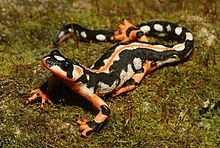Kaiser's spotted newt
| Kaiser's spotted newt | |
|---|---|
 | |
| Conservation status | |
| Scientific classification | |
| Kingdom: | Animalia |
| Phylum: | Chordata |
| Class: | Amphibia |
| Order: | Caudata |
| Family: | Salamandridae |
| Genus: | Neurergus |
| Species: | N. kaiseri |
| Binomial name | |
| Neurergus kaiseri Schmidt, 1952 | |
 | |
| Synonyms | |
|
Neurergus crocatus ssp. kaiseri Schmidt, 1952 | |
Kaiser's spotted newt (Neurergus kaiseri), also known as the Luristan newt or emperor spotted Newt (not to be confused with Tylototriton shanjing), is a species of very colourful salamanders in the Salamandridae family. It is endemic to the southern Zagros Mountains in Iran. It is primarily found in highland streams surrounded by arid scrubland, but can also be found in ponds and pools. Water is absent from its habitat for a significant part of the year, during which this species is known to estivate. It is considered critically endangered due to its tiny range (it inhabits an area of less than 10 km2), continuing habitat loss, and the illegal capture of salamanders for the wild animal trade. By January, 2013, all Kaiser's newts were gone fom the wild, and only live in captivity.
Conservation
The Luristan newt is a candidate for CITES listing. It also has a breeding program at the Sedgwick County Zoo. Iran is planning on starting its own breeding program.[1]
References
- ↑ "Forgotten Species: the fiery Luristan Newt". Jeremy Hance. Mongabay.com. Retrieved 2010-02-14.
External links
- Papenfuss, T., Anderson, S., Kuzmin, S. & Rastegar-Pouyani, N. 2006. Neurergus kaiseri. 2006 IUCN Red List of Threatened Species. Downloaded on 9 July 2007.
- Luristan newt. ARKive. Accessed 2008-09-27.
- Neurergus kaiseri. Caudata Culture. Accessed 2008-09-27.
- Neurergus kaiseri Encyclopedia of Life Listing
